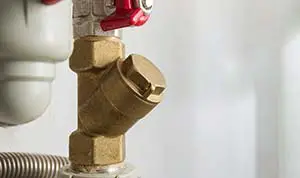Pipelines are an essential part of any industrial process as they facilitate the transmission of liquids and gases from one point to another. However, the smooth flow of materials can sometimes be disrupted by backflow, which can be detrimental to the system's performance. This is where the In Line Check Valve comes into play.

What is an In Line Check Valve?
An In Line Check Valve is a type of check valve that is installed in a pipeline to prevent the backflow of fluids. It is designed to allow the fluid flow in one direction while keeping it from flowing in the opposite direction.
What are the features of an In Line Check Valve?
An In Line Check Valve comes with several features that make it the ideal choice for preventing backflow. Some of these features include:
1. Compact design: As the name suggests, In Line Check Valves are installed in-line with the pipeline, making them very compact and space-saving.
2. Easy installation: In Line Check Valves can be installed in any position and orientation, making them very versatile and easy to install.
3. High durability: These valves are made of durable materials that ensure long-lasting performance even in harsh environments.
4. Low maintenance: In Line Check Valves require minimal maintenance, making them very cost-effective in the long run.
What are the types of In Line Check Valves?
There are several types of In Line Check Valves, each with its specific features and applications. Some of the most common types include:
1. Swing Check Valve: This type of valve has a hinged disc that swings freely to allow fluid flow in one direction and prevent backflow.
2. Lift Check Valve: In this type of valve, the disc is lifted by the fluid pressure to allow the flow and pushed down to stop backflow.
3. Diaphragm Check Valve: This valve has a flexible diaphragm that separates the fluid from the valve mechanism and moves in response to the change in fluid pressure.
What are the applications of In Line Check Valves?
In Line Check Valves are used in a wide range of applications, such as:
1. Water Treatment Plants: These valves are used to control the flow of water and prevent the backflow of treated or contaminated water.
2. Oil and Gas Industry: In Line Check Valves are used to control the flow of oil and gas and prevent the backflow of these fluids in pipelines.
3. Chemical Industry: These valves are used to control the flow of chemicals and prevent the backflow of these hazardous substances.
What are the benefits of using In Line Check Valves?
Using In Line Check Valves comes with several benefits, such as:
1. Improved system performance: In Line Check Valves prevent backflow and ensure a smooth and uninterrupted flow of fluids, resulting in improved system performance.
2. Cost-effective: These valves require minimal maintenance and have a long service life, reducing the overall cost of the system.
3. Safe: In Line Check Valves prevent the backflow of hazardous substances, ensuring the safety of the environment and the people working in it.
4. Versatile: In Line Check Valves can be used for a wide range of applications, making them a versatile solution for fluid control.
Conclusion
In Line Check Valves are an essential component of any fluid control system that requires the prevention of backflow. With their compact design, high durability, and low maintenance requirements, they are an ideal choice for a wide range of applications. Whether you're in the water treatment, oil and gas, or chemical industry, In Line Check Valves are a reliable and cost-effective solution for preventing backflow and ensuring the smooth flow of fluids. So, invest in an In Line Check Valve today and experience improved system performance, safety, and cost savings.